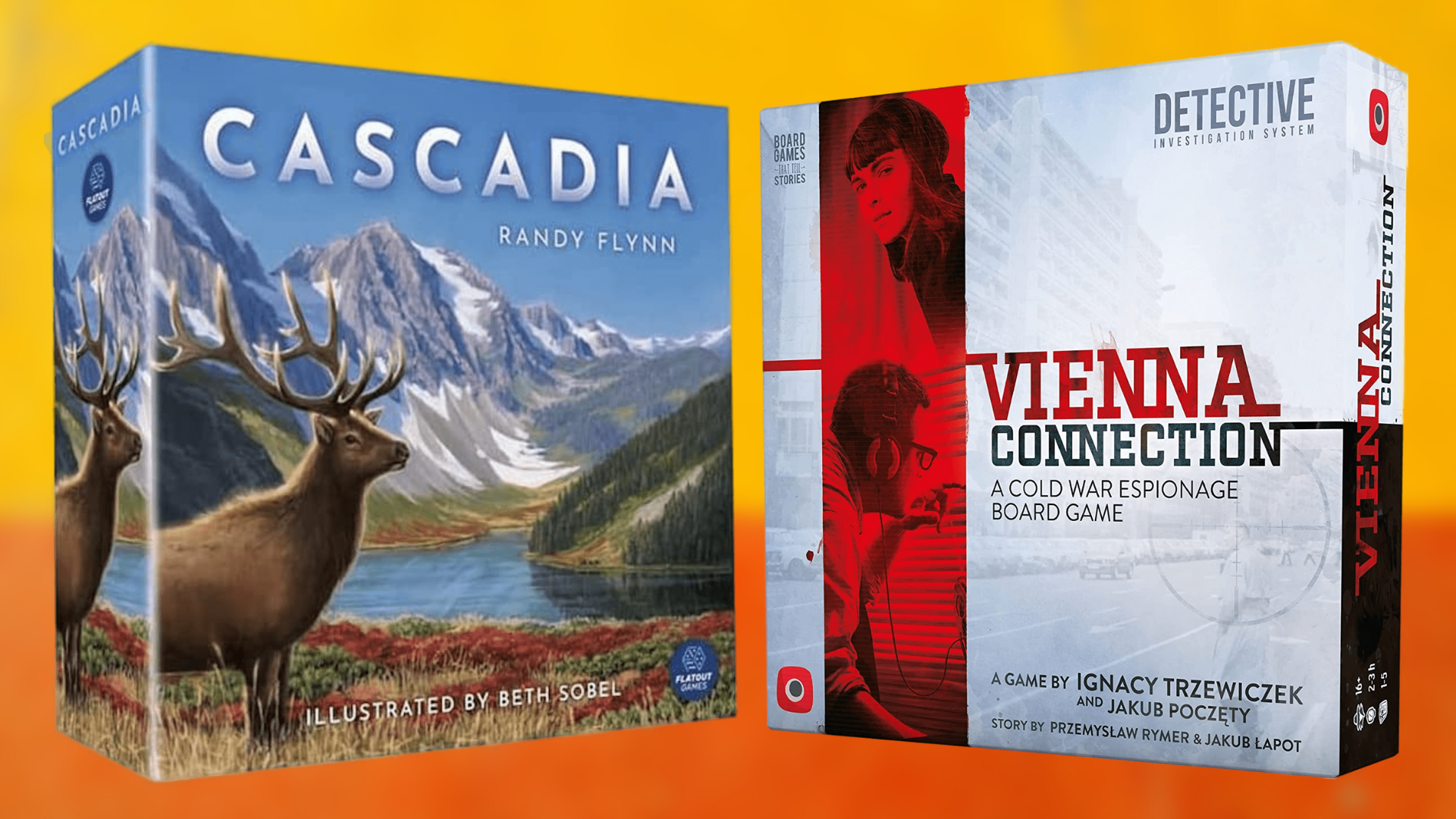There's no shortage of two-player board games -- you can even find plenty of solo board games. And while you might think a group of three players would pose a challenge for board game night, you'd be wrong. Three is actually the perfect number for many games. It allows for more interesting dynamics than strictly two-player, and it affords a quick tempo with little downtime between turns. In many ways, it’s the best qualities of the two and four player format merged together.
The challenge is in finding the right games. That’s why we’re here with this list offering a series of titles that provide an exceptional experience at the three-player count. No need to fret when your fourth cancels as game night can still be salvaged.
TL;DR The Best 3-Player Board Games
- Gloomhaven: Jaws of the Lion
- Dune: Imperium - Uprising
- Wingspan
- Anachrony
- Azul
- Cascadia
- Cthulhu: Death May Die
- Lords of Waterdeep
- Lost Ruins of Arnak
- Raiders of the North Sea
- Splendor
- Vienna Connection
- Viticulture
Gloomhaven: Jaws of the Lion
Gloomhaven has really created a stir the last several years. This RPG-in-a-box spawned multiple offspring, including the more streamlined and accessible Gloomhaven: Jaws of the Lion. This fantasy adventure game has players cooperating to work through dungeons and defeat an array of enemies. Each character possesses a unique deck with a distinct playstyle. Players must leverage each character’s strengths and manage their hand of cards to optimize each action and defeat each challenge put before them. This is a campaign game that requires a lengthy commitment, but the achievement and rewards are much sweeter when experienced with a couple of friends. For additional information, be sure to check out our review of this game.
Dune Imperium: Uprising
Many leaving the theater after seeing Dune 2 will want more. We are fortunate that one of the most beloved board games of the past few years is set in this universe. This game has players balancing military strength with political power by building a personal deck of cards from a public market. You must also acquire resources and build alliances by placing your workers on a myriad of spaces on the board. Both of these systems combine to create a powerful game loop of improving your engine to yield greater rewards. The payout is tremendous in this nuanced game that rewards strategic play and deeper exploration. Three players works wonderfully as it creates just the right amount of competition over spaces on the board and forces you to adapt to an ever-changing landscape.
Wingspan
The ever-popular Wingspan is a nature-themed game that has players competing to collect an array of various birds by drawing cards and playing them in their sanctuary. The birds come to life with over 170 beautiful illustrations alongside delightful components such as small eggs and attractive resource tokens. Each bird offers a unique ability which interfaces with the rest of your sanctuary to create an emerging combination of effects. This is a very inviting and warm game visually, but it also has some heft to it as a game, offering a satisfying strategic foundation for players to repeatedly return to. Three-players is the ideal count, as it creates some healthy competition by pushing each other to thoughtfully expand your group of birds without hurting the tempo of play. You can read our review of this game here.
Anachrony
An asteroid is going to hit the Earth and you have a limited amount of time to prepare to save humanity — but you want to be the one who’s in charge when the dust settles. The complex game lets you gather resources by deploying workers with their own abilities, including some that will be piloting mechs. You can also speed up your progress by using Time Rifts to grab resources from the future so long as you pay them back before time anomalies form. With many paths to victory and different factions to try, there’s plenty of replayability. If you want to add more complexity, you can pick up the Future Imperfect and Fractures of Time expansions.
Azul
Quick and easy to learn, Azul is a great board game to play with your kid or someone you’re introducing to board gaming. Each player is working to form the most beautiful mosaic by drafting tiles from the central market to place on their board, scoring points based on how many you can connect. Full rows, columns and sets of the same type of tile earn big bonus rewards. The beautifully detailed pieces are satisfying to play with as you slide them into place, carefully considering the best move of the moment but also what other players are likely to pick so you don’t lose points from getting stuck with tiles you can’t use.
Cascadia
This soothing family board game challenges players to build a thriving ecosystem based on the Pacific Northwest. Each session is different thanks to the variety of scoring goals, which reward points based on the relative placement of animal tokens. In one game you may try to ensure red tailed hawks are flying solo and in another that they have an unobstructed view to their potential mate. The tiles you draft not only represent where each type of animal can live but different terrain types, and building unbroken expanses of mountains, wetlands and forests can be worth just as much points at the end of the game as having the right animal patterns. Add in pinecones that can be used to mix up the token and tile pairs during drafting and you’ll have plenty to think about each turn.
Cthulhu: Death May Die
Most games based on Lovecraftian horror are about preventing Elder Gods from setting foot on Earth, but it’s already too late for that in Cthulhu: Death May Die. Instead your goal is to arm yourself well enough to be able to shoot the monster in the face. There’s a high level of replayability to the cooperative game thanks to the variety of investigators players can control and the threats of the different Elder Gods and their minions, who are represented through impressively detailed miniatures. Three players gives you a nice variety of character archetypes without making the game take too long, which can happen when there are five people choosing the best way to take their actions. You still need to be careful though, since the game ends if a single investigator is eliminated before the Elder is summoned.
Lords of Waterdeep
Lords of Waterdeep provides an excellent introduction to the worker placement genre and is especially fun for D&D players who will recognize the references to the Forgotten Realms. Players take on the roles of secret Lords of Waterdeep, each with their own strengths, and will try to establish influence over the City of Splendors by recruiting various types of adventurers to send on quests. Some quests provide powerful boosts that will make it easier for you to gain more resources throughout the game while others are worth a huge amount of points, so you’ll have to think carefully about your priorities as the rounds progress. Players can also build new locations on the map that they can use themselves and they’ll rake in rewards when a rival takes advantage of them. If you prefer a more competitive experience or want to play with a bigger group, pick up the Scoundrels of Skullport expansion.
Lost Ruins of Arnak
Fusing worker placement and deckbuilding, Lost Ruins of Arnak tasks each player with learning the secrets of a mysterious island. There are so many ways to earn points that it’s a real challenge to figure out which is best to pursue, especially since you’re directly competing with your opponents to be the first to nab bigger rewards. You can focus on exploring new areas and fighting fearsome guardians, conduct research, try to improve your deck, or recruit assistants that will make your work easier. The game board is tailored based on the number of players so it’s as well balanced for three as it is for two or four. There’s a solo variant if you want to play alone or are looking for a good way to practice strategies.
Raiders of the North Sea
Be a Viking with this worker placement game, where you’ll need to put together a crew and gather enough resources to successfully raid increasingly well-protected settlements. You’ll collect silver to hire crew members, who will help determine your strategy since they can give you bonuses when attacking specific targets. They can also die and become Valkyrie that will earn points you need to win. You also have to take the time to convert your plunder into offerings for the chieftain, though the amount of favor you’ve earned is kept a secret until the end of the game. Choose your actions wisely as the game can end quickly as players rush to make offerings and launch their boats deeper into the territories at the bottom of the board.
Splendor
This fast game is easy enough for kids to learn but satisfying for players of all ages, making it a good board game for families. Compete to build a thriving jewelry business by gathering gem tokens which can be used to purchase developments and win the favor of nobles. You’ll want to try to take actions as efficiently as possible, keeping track of what resources your opponents are gathering and when they are likely to purchase a development so you don’t miss the opportunity or get stuck waiting for them to stop hoarding a key resource. You also should plan long term, looking at the bonus gems needed to attract each noble since you can only pick up one per turn and their high point values can be the difference between winning or losing.
Vienna Connection
Feel like a spy with Vienna Connection, where players work together to uncover a mystery in Cold War Europe. While the game can be played solo or with two players, the difficulty is meant for three or more people putting their heads together to solve puzzles, which can involve cracking codes, remembering details from cards, and even conducting research on the internet into real world history. The game is played over the course of four interconnected missions so you’ll want to have a group that’s committed to seeing the case through to the end. You’ll store your progress with a companion website that also plays audio and video to make the gameplay more immersive.
Viticulture
You’ve inherited an unimpressive Tuscan vineyard and you have to build it up into something to be proud of in this charming strategic game that takes place over a series of seasons. In summer you’ll deploy workers to plant vines, build structures and sell grapes, while in winter you’ll harvest crops and start aging your wines. You can develop more complex and valuable varieties based on the types of grapes you grow and how much work you’ve done in your cellar, which you can then use to fulfill orders and earn more money to make additional improvements to the vineyard. Pop open a bottle of wine and settle in to learn a bit about how it’s produced as you play.
For a wide variety of additional roundups, check out our picks for the best board games for 5 year olds, plus the best Warhammer alternatives and the best war board games.





